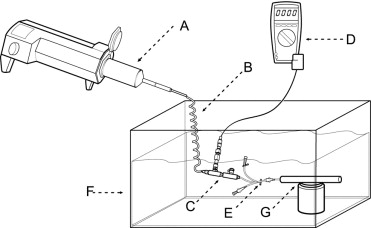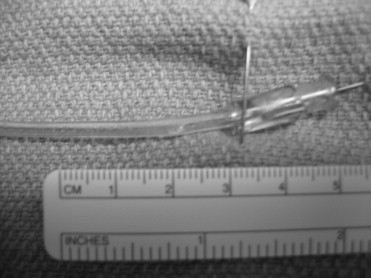Rationale and Objectives
Computed tomographic angiography (CTA) requires the rapid injection of contrast media ideally through an 18-gauge intravenous line in the antecubital fossa. Patients with CVCs undergoing CTA, however, are typically injected at low rates for two reasons: the potential for catheter failure and because of the lack of manufacturer recommendations for high injection rates typically used during CTA. The purpose of the study is to measure the injection rate thresholds of CVC. The results suggest that CVC can be used at high injection rates that are now typically used with peripheral intravenous catheters during CTA.
Materials and Methods
We used 16-cm-long catheters and 20-cm-long catheters in six groups (n = 5 for each catheter length). After the catheters were placed into a water bath, each group was injected at 5, 10, 15, 20, 25, and 30 ml/sec. New contrast, pressure tubing, and catheters were used for each test.
Results
No catheter ruptures were encountered during the experiment, but there was one episode of power injector tubing rupture during the injection of a 16-cm catheter at an injection rate of 30 ml/sec.
Conclusion
No catheter failures were demonstrated in this study using injection rates well above those used in conventional CTA. Power injector tubing failure was demonstrated at an injection rate of 30 ml/sec, which generated mean pressures in the 16-cm catheters of 920 psi (tubing rating per manufacturer is 300 psi). This study demonstrated no catheter or injector tubing failure at injection rates of 5 to 25 ml/sec.
Computed tomography (CT) is widely used in patients with intravenous devices. With the advent of CT angiography (CTA), there is a requirement for the rapid infusion of contrast media (CM) using a power injector at injection rates of 4 ml/sec and higher through intravenous (IV) access achieved ideally by an 18-gauge IV line in the antecubital fossa. Patients with limited IV options can have IV access achieved by several methods, including indwelling ports (Hickman, Broviac catheters, etc), peripherally inserted central catheters (PICC lines), and central venous catheters (CVCs). CVCs, typically triple-lumen catheters, are commonly placed in acutely ill patients in emergency departments and intensive and critical care units.
To our knowledge, there are no guidelines from the manufacturers of CVCs regarding maximal injection rate thresholds. Data regarding the feasibility and safety of power injection of CM through CVCs are limited. As a consequence, CVCs are not used for examinations requiring high injection rates due to several possible concerns. Potential complications are possible rupture under high injection flow rates causing catheter fragmentation and/or vessel injury and extravasation of CM, ultimately leading to patient morbidity.
Get Radiology Tree app to read full this article<
Get Radiology Tree app to read full this article<
Materials and methods
Get Radiology Tree app to read full this article<
Get Radiology Tree app to read full this article<
Get Radiology Tree app to read full this article<
Get Radiology Tree app to read full this article<
Get Radiology Tree app to read full this article<
Get Radiology Tree app to read full this article<
Results
Get Radiology Tree app to read full this article<
Get Radiology Tree app to read full this article<
Table 1
Catheter Lengths and Injection Rates
Catheter Length (cm) Injection Rate (ml/sec) No. Mean Pressure (psi) SD_P_ Value 16 5 5 120 2.2 0.0002 20 5 5 129 2.3 16 10 5 310 5.7 0.0075 20 10 5 324 6.9 16 15 5 528 12 0.0007 20 15 5 565 8.2 16 20 5 753 14.3 0.26 20 20 5 768 22.6 16 25 5 916 17.7 0.06 20 25 5 886 23.7 16 30 5 920 25.7 0.0161 20 30 5 872 24.2
Get Radiology Tree app to read full this article<
Get Radiology Tree app to read full this article<
Get Radiology Tree app to read full this article<
Discussion
Get Radiology Tree app to read full this article<
Get Radiology Tree app to read full this article<
Get Radiology Tree app to read full this article<
Get Radiology Tree app to read full this article<
Get Radiology Tree app to read full this article<
Get Radiology Tree app to read full this article<
Get Radiology Tree app to read full this article<
Get Radiology Tree app to read full this article<
Get Radiology Tree app to read full this article<
Get Radiology Tree app to read full this article<
Get Radiology Tree app to read full this article<
Acknowledgments
Get Radiology Tree app to read full this article<
Get Radiology Tree app to read full this article<
Get Radiology Tree app to read full this article<
References
1. Brown D.B., Papadouris D.C., Davis R.V., et. al.: Power injection of microcatheters: An in vitro comparison. J Vasc Interv Radiol 2005; 16: pp. 101-106.
2. Coyle D., Bloomgarden D., Beres R., et. al.: Power injection of contrast media via peripherally inserted central venous catheters for CT. J Vasc Interv Radiol 2004; 15: pp. 809-814.
3. Rivitz S.M., Drucker E.A.: Power injection of peripherally inserted central catheters. J Vasc Interv Radiol 1997; 8: pp. 857-863.
4. Salis A.I., Eclavea A., Johnson M.S., et. al.: Maximal flow rates possible during power injection through currently available PICCs: An in vitro study. J Vasc Interv Radiol 2004; 15: pp. 275-281.
5. Herts B.R., O’Malley C.M., Wirth S.L., et. al.: Power injection of contrast media using central venous catheters: Feasibility, safety, and efficacy. AJR Am J Roentgenol 2001; 176: pp. 447-454.
6. Carlson J.E., Hedlund L.J., Trenkner S.W., et. al.: Safety considerations in the power injection of contrast media via central venous catheters during computed tomography examinations. Invest Radiol 1992; 27: pp. 337-340.
7. Reynolds N.J., Grosvenor L.J.: Problems with the rapid powered injection of radiology contrast through multilumen catheters. Anaesthesia 2003; 58: pp. 923-924.
8. Sanelli P.C., Deshmukh M., Ougorets I., et. al.: Safety and feasibility of using a central venous catheter for rapid contrast injection rates. AJR Am J Roentgenol 2004; 183: pp. 1829-1834.
9. Herts B.R., Cohen M.A.H., McInroy B., et. al.: Power injection of intravenous contrast media through central venous catheters for CT: In vitro evaluation. Radiology 1996; 200: pp. 731-735.
10. Ruess L., Bulas D.I., Rivera O., et. al.: In-line pressures generated in small-bore central venous catheters during power injection of CT contrast media. Radiology 1997; 203: pp. 625-629.
11. Miles S.G., Rasmussen J.F., Litwiller T., et. al.: A safe use of an intravenous power injector for CT: Experiment and protocol. Radiology 1990; 176: pp. 69-70.
12. Sistrom C.L., Gay S.B., Peffley L.: Extravasation of iopamidol and iohexol during contrast-enhanced CT: Report of 28 cases. Radiology 1991; 180: pp. 707-710.
13. Federle M.P., Chang P.J., Sharmen C., et. al.: Frequency and effects of extravasation of ionic and nonionic CT contrast media during rapid bolus injection. Radiology 1998; 206: pp. 637-640.
14. Rogalla P., Meiri N., Thoeni R.F., et. al.: Safe and easy power injection of contrast material through a central line. Eur Radiol 1998; 8: pp. 148-149.
15. Kaste S.C., Young C.W.: Safe use of power injectors with central and peripheral venous access devices for pediatric CT. Pediatr Radiol 1996; 26: pp. 499-501.

